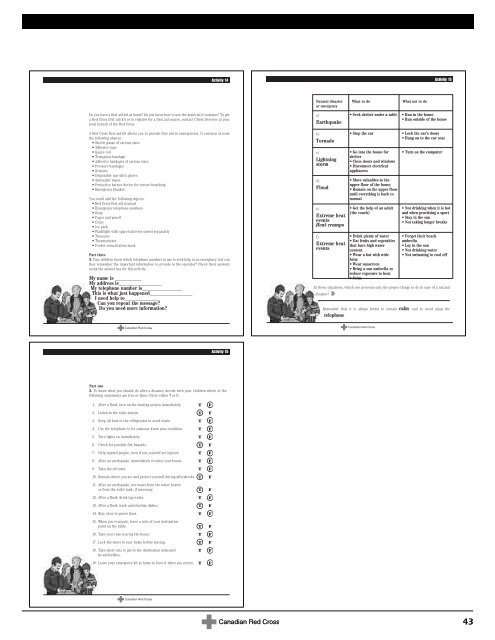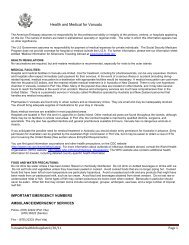3-1-2-1-Expect-the-Unexpected
3-1-2-1-Expect-the-Unexpected
3-1-2-1-Expect-the-Unexpected
- No tags were found...
You also want an ePaper? Increase the reach of your titles
YUMPU automatically turns print PDFs into web optimized ePapers that Google loves.
Activity 14Activity 15Natural disaster What to do What not to door emergencyDo you have a first aid kit at home? Do you know how to use <strong>the</strong> material it contains? To geta Red Cross first aid kit or to register for a first aid course, contact Client Services at yourlocal branch of <strong>the</strong> Red Cross.a)Earthquake• Seek shelter under a table• Run in <strong>the</strong> house• Run outside of <strong>the</strong> houseA Red Cross first aid kit allows you to provide first aid in emergencies. It contains at least<strong>the</strong> following objects:• Sterile gauze of various sizes• Adhesive tape• Gauze roll• Triangular bandage• Adhesive bandages of various sizes• Pressure bandages• Scissors• Disposable non-latex gloves• Antiseptic wipes• Protective barrier device for rescue breathing• Emergency blanketYou could add <strong>the</strong> following objects:• Red Cross first aid manual• Emergency telephone numbers• Soap• Paper and pencil• Coins• Ice pack• Flashlight with spare batteries stored separately• Tweezers• Thermometer• Pocket resuscitation maskPart three3. Your children know which telephone numbers to use to seek help in an emergency, but can<strong>the</strong>y remember <strong>the</strong> important information to provide to <strong>the</strong> operator? Check <strong>the</strong>ir answersusing <strong>the</strong> answer key for this activity.My name is __________My address is________________My telephone number is_______________This is what just happened________________I need help to_____________Can you repeat <strong>the</strong> message?Do you need more information?b)Tornadoc)Lightningstormd)Floode)Extreme heateventsHeat crampsf)Extreme heatevents• Stop <strong>the</strong> car• Go into <strong>the</strong> house forshelter• Close doors and windows• Disconnect electricalappliances• Move valuables to <strong>the</strong>upper floor of <strong>the</strong> house• Remain on <strong>the</strong> upper flooruntil everything is back tonormal• Get <strong>the</strong> help of an adult(<strong>the</strong> coach)• Drink plenty of water• Eat fruits and vegetablesthat have high watercontent• Wear a hat with widebrim• Wear sunscreen• Bring a sun umbrella toreduce exposure to heat• Swim• Lock <strong>the</strong> car’s doors• Hang on to <strong>the</strong> car seat• Turn on <strong>the</strong> computer• Not drinking when it is hotand when practising a sport• Stay in <strong>the</strong> sun• Not taking longer breaks• Forget <strong>the</strong>ir beachumbrella• Lay in <strong>the</strong> sun• Not drinking water• Not swimming to cool offIn <strong>the</strong>se situations, which one presents only <strong>the</strong> proper things to do in case of a naturaldisaster? DRemember that it is always better to remain calm and to avoid using <strong>the</strong>telephone.Activity 15Part two2. To know what you should do after a disaster, decide with your children which of <strong>the</strong>following statements are true or false. Circle ei<strong>the</strong>r T or F.1. After a flood, turn on <strong>the</strong> heating system immediately.2. Listen to <strong>the</strong> radio station.3. Keep all food in <strong>the</strong> refrigerator to avoid waste.4. Use <strong>the</strong> telephone to let someone know your condition.5. Turn lights on immediately.6. Check for possible fire hazards.7. Help injured people, even if you yourself are injured.8. After an earthquake, immediately re-enter your house.9. Take <strong>the</strong> elevator.10. Remain where you are and protect yourself during aftershocks.11. After an earthquake, use water from <strong>the</strong> water heateror from <strong>the</strong> toilet tank, if necessary.12. After a flood, drink tap water.13. After a flood, wash and sterilize dishes.14. Stay close to power lines.15. When you evacuate, leave a note of your destinationpoint on <strong>the</strong> table.16. Take your time leaving <strong>the</strong> house.17. Lock <strong>the</strong> doors to your home before leaving.18. Take short cuts to get to <strong>the</strong> destination indicatedby authorities.19. Leave your emergency kit at home to have it when you return.TTTTTTTTTTTTTTTTTTTFFFFFFFFFFFFFFFFFFF43



